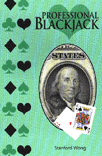
Professional Blackjack
Wong's 'Professional Blackjack' Explores High-Low Count in Comprehensive Book
There are many counting systems used by serious blackjack players, but possibly the most commonly used is the High-Low count. Stanford Wong wasn't the first person to come up with this counting Nick Christenson is widely regarded as one of the best gambling book reviewers publishing today. He is a contributor for Poker Player magazine, and has published in Full-Tilt and Gambling Times. He is also the editor of the very funny 'Casino Death Watch,' which chronicles the comings and goings of casinos in Las Vegas. He is an avid poker and blackjack player. Nick's website is www.jetcafe.org/~npc/ method, but due to his research and published information, his name will forever be linked with it. Professional Blackjack is Wong's comprehensive description of how to play this system.
Nick Christenson is widely regarded as one of the best gambling book reviewers publishing today. He is a contributor for Poker Player magazine, and has published in Full-Tilt and Gambling Times. He is also the editor of the very funny 'Casino Death Watch,' which chronicles the comings and goings of casinos in Las Vegas. He is an avid poker and blackjack player. Nick's website is www.jetcafe.org/~npc/ method, but due to his research and published information, his name will forever be linked with it. Professional Blackjack is Wong's comprehensive description of how to play this system.
Wong starts at the beginning, with a description of the game of blackjack, definition of common terms, and basic strategy. This is all the sort of solid information that one would expect from the author. He then moves into explaining the High-Low count system in considerable detail, how it works, what its edge is, how strategy changes with the count for a wide variety of game rules, taking insurance, etc.. This is almost as comprehensive as his work in Basic Blackjack, including such tables as count adjusted strategies for four card hands if the game pays a six card automatic winner. Some of the information, like this last example, is probably more detailed than the reader is likely to need. I can't imagine that anybody has taken the time to memorize all of these tables. However, the information is here if one wants it.
Wong also provides information on a count to beat the Over/Under 13 side-game offered at some casinos (although I haven't seen it in years), as well as a detailed explanation of the very complex three-level Wong Halves Count. If one is interested in these systems, this book is the place to look for them.
After this, Wong covers some miscellaneous topics, such as one's expected win rate, optimal bet sizing, ace side-counts, and a great deal of research on the effects of shuffles and the search for the elusive "card clumping" phenomenon. This is good information. Finally, the book concludes with about 100 pages of charts showing computer simulations of hands and situations, win rates for various games, initial hand frequencies, a glossary, and a good, if slightly dated at the time I write this, bibliography.
This book was originally written long before Don Schlesinger wrote his "Illustrious 18" article for Blackjack Forum (later published in his excellent book Blackjack Attack) which triggered a great deal of interest in quantitatively prioritizing which strategy variations are worth the time to memorize and which are not. Therefore, there's a lot of information in this book that's really not worth the effort to keep in one's head. However, the reader can count on the information presented in Professional Blackjack to be correct.
This is a very thorough treatment of the High-Low count, probably more so than one needs. The book doesn't cover key issues like one's act, betting structures, etc., but that information is available elsewhere, including other books by Wong. Therefore, if someone is researching which counting system they ought to use, I'd recommend reading Wong's Blackjack Secrets first, and then if one decided to use the High-Low, (or if information on the Over-Under 13 or Wong's Halves Count was interesting), then they should definitely pick up Professional Blackjack. However, even if one doesn't learn the High-Low, this book would still be an extraordinarily worthwhile part of the blackjack player's library.
